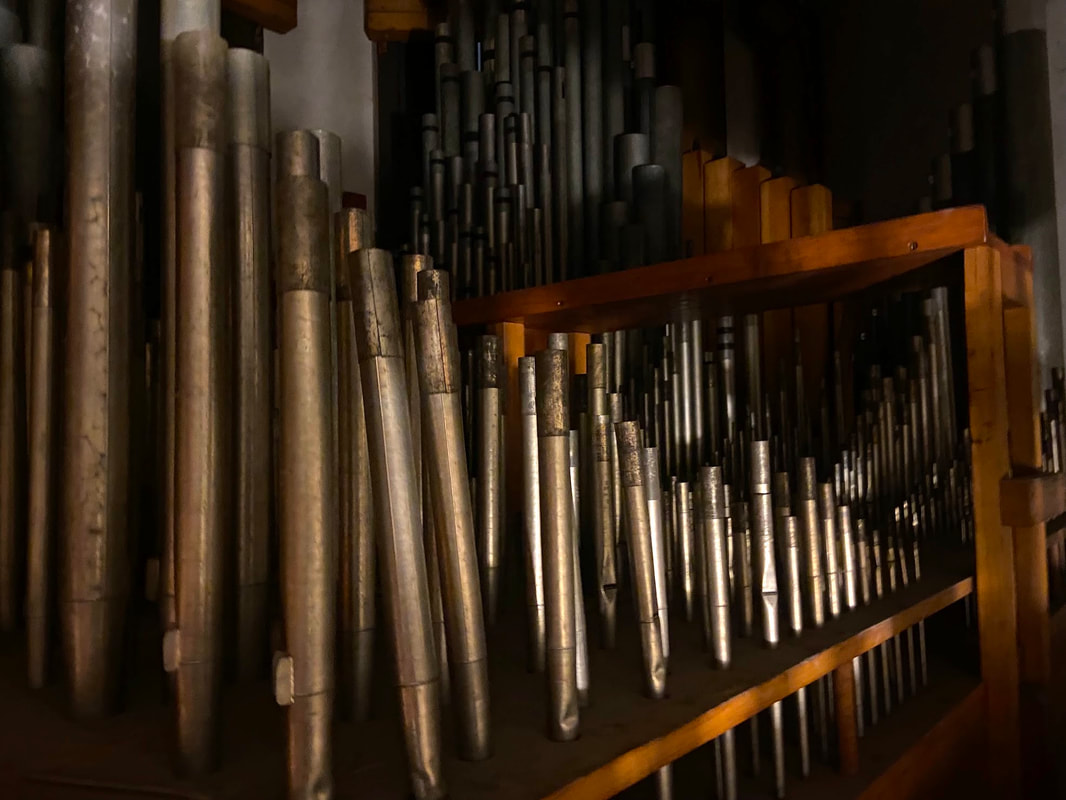|
The Worcester Memorial Auditorium is a piece of living history, and touring the space with new visitors will never get old. They are often awed by the enormity of the auditorium and the grandeur and solemnity of the WWI memorial hall. One of our favorite kinds of tours, though, are the ones that include a close look at the Auditorium’s Kimball organ. Most people can appreciate the sheer size and scale of the instrument, but it’s the musicians that stop and gape. This fall, John Roper of Plenum Organ Company, stopped by to conduct an on-site inspection of the instrument, and shared so much information with us. The following are excerpts from his report. “The Kimball organ, housed within the Worcester Memorial Auditorium, was constructed in 1933 and is designated as that builder’s opus number 7199. Comprising 107 ranks, or sets of pipes, the organ boasts a total of 6,841 pipes. These pipes, varying in length from 32 feet to 6 inches, are meticulously crafted from a blend of metal and wood materials. Pipe organs are some of the most complex creations ever made, combining mechanical and electrical parts, all handcrafted from wood, metal, leather, and other materials. Their precise construction ensures their durability. However, like any item made from natural materials, organs need regular care to keep working. While it did receive some attention in 2016, the organ in the Memorial Auditorium has been left idle for some time. As a result of this dormancy, it now needs some work to make it fully playable again. This instrument is a historically significant piece due to its builder, Kimball, a renowned name in the world of organ design and construction. Kimball was known for its tonal design philosophy and was instrumental in the "Symphonic" style of organ building, which sought to make the most lush and warm-sounding orchestral-style instruments. This particular organ, built in 1933, stands as a testament to the high-quality craftsmanship of the firm and the sound of its instruments. Moreover, the organ's unaltered state enhances its historical value, offering a unique glimpse into the original craftsmanship and design philosophy of the era. It is a rare sight to see a Kimball (Chicago) organ in New England which was dominated by the Boston-based builders of the day. The preservation of such an instrument provides invaluable insights into the evolution of organ design and the musical history of the early 20th century. Therefore, it is not just an instrument, but a piece of history that deserves to be valued and preserved. A fitting piece for the auditorium. It's important to note that the organ remains in remarkable condition compared to many of its contemporaries, some of which have been modified or even destroyed. The majority of the issues listed (such as leather deterioration and outdated wiring) are expected given the instrument's age. After all, even we as humans experience wear and tear over time. I strongly recommend leaving the instrument enclosed and unmodified in its current location to ensure its preservation for future generations.” We are so thankful for John’s visit and his report, and we leave you with this moment of stunning beauty, as John plays the Worcester Memorial Auditorium’s 1933 Kimball Organ. Comments are closed.
|
AuthorArchitectural Heritage Foundation (AHF) is working to preserve and redevelop the Worcester Memorial Auditorium as a cutting-edge center for digital innovation. Archives
May 2022
Categories
All
|

 RSS Feed
RSS Feed